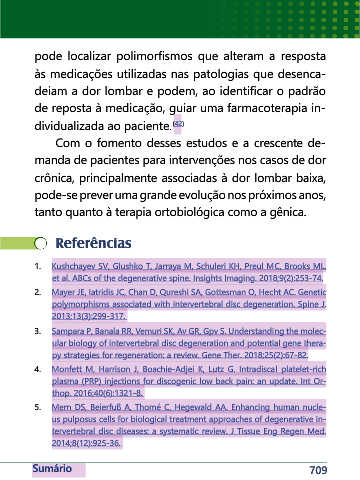Page 711 - Livro Tratado de lesões da coluna no esporte
P. 711
pode localizar polimorfismos que alteram a resposta
às medicações utilizadas nas patologias que desenca-
deiam a dor lombar e podem, ao identificar o padrão
de reposta à medicação, guiar uma farmacoterapia in-
dividualizada ao paciente. (42)
Com o fomento desses estudos e a crescente de-
manda de pacientes para intervenções nos casos de dor
crônica, principalmente associadas à dor lombar baixa,
pode-se prever uma grande evolução nos próximos anos,
tanto quanto à terapia ortobiológica como a gênica.
Referências
1. Kushchayev SV, Glushko T, Jarraya M, Schuleri KH, Preul MC, Brooks ML,
et al. ABCs of the degenerative spine. Insights Imaging. 2018;9(2):253-74.
2. Mayer JE, Iatridis JC, Chan D, Qureshi SA, Gottesman O, Hecht AC. Genetic
polymorphisms associated with intervertebral disc degeneration. Spine J.
2013;13(3):299-317.
3. Sampara P, Banala RR, Vemuri SK, Av GR, Gpv S. Understanding the molec-
ular biology of intervertebral disc degeneration and potential gene thera-
py strategies for regeneration: a review. Gene Ther. 2018;25(2):67-82.
4. Monfett M, Harrison J, Boachie-Adjei K, Lutz G. Intradiscal platelet-rich
plasma (PRP) injections for discogenic low back pain: an update. Int Or-
thop. 2016;40(6):1321-8.
5. Mern DS, Beierfuß A, Thomé C, Hegewald AA. Enhancing human nucle-
us pulposus cells for biological treatment approaches of degenerative in-
tervertebral disc diseases: a systematic review. J Tissue Eng Regen Med.
2014;8(12):925-36.
Sumário 709

